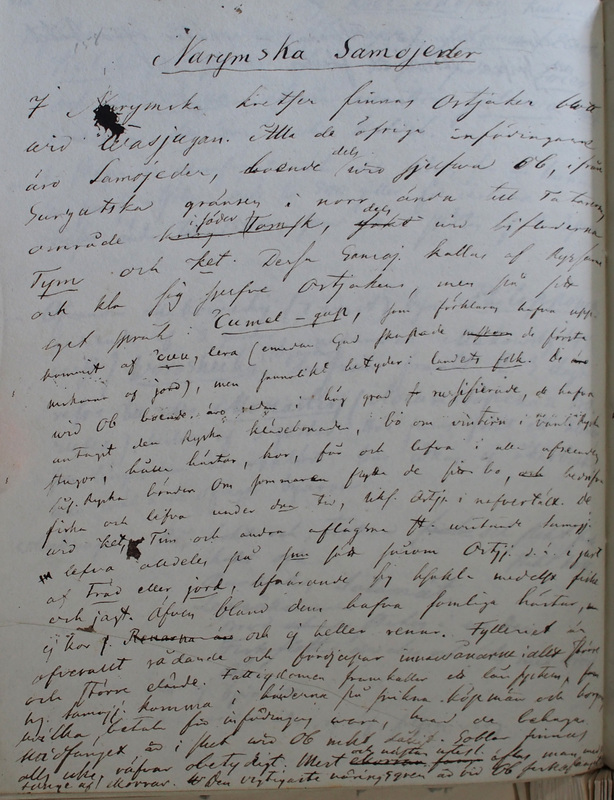Ethnographiska, historiska och statistiska anmärkningar. 226
Title
Ethnographiska, historiska och statistiska anmärkningar. 226
Description
| Narymska Samojeder I Narymska kretsen finnas Ostjaker blott wid Wasjugan.
Alla de öfriga infödingarneThe River Vas’jugan discharges into the Obʹ. (GVR)
dels äro Samojeder, boende wid sjelfva Ob, ifrån Surgutska gränsen i norr ända till Tatarens område i söder kring Tomsk, dels wid bifloderna Tym
och
The Tym flows into the Obˈ from the right (north) at N59°25′55″ E80°1′40″. (TS)
Ket.
Dessa Samoj.
The River Ket flows into the River Balej. (GVR)
[Samojeder]
kallas
af RyssarneWhat has been called Selkup since the 1930s, according to Prokofʹev’s suggestion, is an ethno-linguistic category that was not recognised by the Selkups – and partly still is not. The ethnonym Selkup goes back to the Taz and Turukhansk dialect ethnonyms of селькуп and шолькуп respectively, meaning ʻtaiga man’. However, the Tym, Vas’jugan, Parabelʹ, and communities living lower on the Narym call themselves чумыл-куп, ʻearth man’; communities living on the middle and upper Ket сюссы-кум; communities living on the Ob’ up from Narym шëш-кум, both meaning ‘taiga man’. In Russian the northern Selkups have customarily been named Ostyak Samoyeds, whereas in the more southern living regions only the term Ostyak has been in use. (Vasil’jev 2005: 305–306)
och kla[kalla] sig sjelfve Ostjaker, men på sitt eget språk *Cumel-gup,
som förklaras hafva upp-SE čúmêl-gup ‘Ostyak; Samoyed’. See [MC Ostiak-Samoiedica’s vocabulary] and [kallas].
kommit af *cuu, lera (emedan Gud skapade mskor de första mskorna af jord), men sannolikt betyder: landets folk. De äro wid Ob boende äro redani hög grad russifierade, de hafva antagit den Ryska klädebonaden, bo om vintern i vanl. Ryska stugor, hålla höstar, kor, får och lefva i alla afseenden sås[om]. Ryska bönden. Om sommaren flytta de sitt bo, och bedrifva fiske och lefva under dna[denna] tid, liks[om]. Ostjj. [Ostjaker] i nafvertält.
DeAs noted by Sokolova (1998: 21–22), the reindeer-herding Selkups lived in conical tents all year round. Accordingly, the covering consisted of reindeer hides in the winter and birch bark in the summer. Castrén refers here to hunters and gatherers, who used conical tents only during the summer.
wid Ket, Tim och andra aflägsna st[ällen]. vistande Samojj.[Samojeder] lefva alldeles på sma[samma] sätt såsom Ostjj.[Ostjaker] d. ä. i jurt
The Selkups lived in several types of subterranean or semi-subterranean buildings and huts, in Russian ‘jurt’. See Sokolova 1998: 22–26.
af träd eller jord, lifnärande sig hsakl.[hufvudsaligen] medelst fiske och jagt. Äfven bland dem hafva somliga hästar, ej kor Renarna äro och ej heller renar. Fylleriet är öfverallt rådande och fördjupar innewånarne i allt större och större elände. Fattigdomen framkallar ett lånsystem, som Samojj. [Samojeder] komma i händerna på svikna köpmän och borgar, hvilka betala för infödingens wara, hvad de behaga. |
Narym Samoyeds In the Narym uezd, there are Ostyaks only by the River Wasjugan. All the other natives are partly Samoyeds, living by the Ob, from the Surgut border in the north all the way to the Tatar area in the south, partly by the tributaries the Tym and the Ket. These Samoyeds are called Ostyaks by the Russians and by themselves, but in their own language *Cumel-gup, which they say comes from *cuu ‘clay’ (because God created the first men from clay, but probably means the people of the country. Those who live by the Ob are already highly Russified; they have adopted Russian dress, spend the winter in typical Russian cottages, have horses, cows, and sheep, and live in all respects like the Russian peasants. In the summer they move back to their dwellings and practise fishing and during this time they live like Ostyaks in birch bark tents. Those Samoyeds that live by the Ket and Tym and in other distant places live in just the same way as the Ostyaks, in other words, in yurts made of trees or earth, nourishing themselves mainly through fishing and hunting. Even among them some have horses, not cattle or reindeer. Drunkenness prevails everywhere and immerses the inhabitants in ever greater and greater misery. Poverty leads to a credit system, in which the Samoyeds are driven into the hands of deceptive merchants, who charge the natives whatever pleases them. |
| Wilddfånget är i shet[synnerhet] wid Ob mket[mycket] dåligt. Soblar finnas nästan utesl.[uteslutande] alls icke, räfvar obetydligt. Mest och nästan utesl. [uteslutande] äflas man med fångst af ekorrar: Den vigtigaste näringsgren äre vid Ob fiskefångst |
The hunting of wild animals is particularly bad by the Ob. There are very few sables and the number of foxes is insignificant. Mostly, and almost exclusively, they practise squirrel hunting; the most important source of livelihood by the Ob is fishing. |

